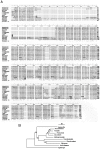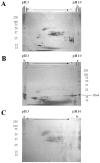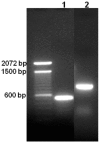The unique biosynthetic route from lupinus beta-conglutin gene to blad
- PMID: 20066045
- PMCID: PMC2798717
- DOI: 10.1371/journal.pone.0008542
The unique biosynthetic route from lupinus beta-conglutin gene to blad
Abstract
Background: During seed germination, beta-conglutin undergoes a major cycle of limited proteolysis in which many of its constituent subunits are processed into a 20 kDa polypeptide termed blad. Blad is the main component of a glycooligomer, accumulating exclusively in the cotyledons of Lupinus species, between days 4 and 12 after the onset of germination.
Principal findings: The sequence of the gene encoding beta-conglutin precursor (1791 nucleotides) is reported. This gene, which shares 44 to 57% similarity and 20 to 37% identity with other vicilin-like protein genes, includes several features in common with these globulins, but also specific hallmarks. Most notable is the presence of an ubiquitin interacting motif (UIM), which possibly links the unique catabolic route of beta-conglutin to the ubiquitin/proteasome proteolytic pathway.
Significance: Blad forms through a unique route from and is a stable intermediary product of its precursor, beta-conglutin, the major Lupinus seed storage protein. It is composed of 173 amino acid residues, is encoded by an intron-containing, internal fragment of the gene that codes for beta-conglutin precursor (nucleotides 394 to 913) and exhibits an isoelectric point of 9.6 and a molecular mass of 20,404.85 Da. Consistent with its role as a storage protein, blad contains an extremely high proportion of the nitrogen-rich amino acids.
Conflict of interest statement
Figures




Similar articles
-
Identification and characterisation of seed storage protein transcripts from Lupinus angustifolius.BMC Plant Biol. 2011 Apr 4;11:59. doi: 10.1186/1471-2229-11-59. BMC Plant Biol. 2011. PMID: 21457583 Free PMC article.
-
Accumulation of a lectin-like breakdown product of beta-conglutin catabolism in cotyledons of germinating Lupinus albus L. seeds.Planta. 1997 Sep;203(1):26-34. doi: 10.1007/s00050161. Planta. 1997. PMID: 9299789
-
Biosynthesis, cDNA and amino acid sequences of a precursor of conglutin delta, a sulphur-rich protein from Lupinus angustifolius.Plant Mol Biol. 1990 Dec;15(6):879-93. doi: 10.1007/BF00039427. Plant Mol Biol. 1990. PMID: 2103479
-
gamma-Conglutin, the Lupinus albus XEGIP-like protein, whose expression is elicited by chitosan, lacks of the typical inhibitory activity against GH12 endo-glucanases.Phytochemistry. 2010 Feb;71(2-3):142-8. doi: 10.1016/j.phytochem.2009.11.001. Epub 2009 Dec 3. Phytochemistry. 2010. PMID: 19962718
-
Proteomics for exploiting diversity of lupin seed storage proteins and their use as nutraceuticals for health and welfare.J Proteomics. 2016 Jun 30;143:57-68. doi: 10.1016/j.jprot.2016.03.026. Epub 2016 Mar 18. J Proteomics. 2016. PMID: 26996462 Review.
Cited by
-
Enzymatic hydrolysis of lupin protein isolates-Changes in the molecular weight distribution, technofunctional characteristics, and sensory attributes.Food Sci Nutr. 2019 Jul 25;7(8):2747-2759. doi: 10.1002/fsn3.1139. eCollection 2019 Aug. Food Sci Nutr. 2019. PMID: 31428363 Free PMC article.
-
Lupinus albus Protein Components Inhibit MMP-2 and MMP-9 Gelatinolytic Activity In Vitro and In Vivo.Int J Mol Sci. 2021 Dec 10;22(24):13286. doi: 10.3390/ijms222413286. Int J Mol Sci. 2021. PMID: 34948082 Free PMC article.
-
Fusion proteins towards fungi and bacteria in plant protection.Microbiology (Reading). 2018 Jan;164(1):11-19. doi: 10.1099/mic.0.000592. Epub 2017 Dec 14. Microbiology (Reading). 2018. PMID: 29239714 Free PMC article.
-
A nontoxic polypeptide oligomer with a fungicide potency under agricultural conditions which is equal or greater than that of their chemical counterparts.PLoS One. 2015 Apr 7;10(4):e0122095. doi: 10.1371/journal.pone.0122095. eCollection 2015. PLoS One. 2015. PMID: 25849076 Free PMC article.
-
Evaluation of the Major Seed Storage Proteins, the Conglutins, Across Genetically Diverse Narrow-Leafed Lupin Varieties.Front Nutr. 2022 May 13;9:842168. doi: 10.3389/fnut.2022.842168. eCollection 2022. Front Nutr. 2022. PMID: 35634370 Free PMC article.
References
-
- Astwood JD, Silvanovich A, Bannon GA. Vicilins: A case study in allergen pedigrees. J Allergy Clin Immunol. 2002;110:26–27. - PubMed
-
- Ferreira RB, Freitas R, Teixeira AR. The structure of Lupinus seed storage proteins. Recent developments Curr Topics Plant Biol. 2003;4:139–150.
-
- Shutov AD, Baumlein H, Blattner FR, Muntz K. Storage and mobilization as antagonistic functional constraints on seed storage globulin evolution. J Exp Bot. 2003;54:1645–1654. - PubMed
-
- Gallardo K, Lesignor C, Darmency M, Burstin J, Thompson R, et al. Mathesius U,, editor. Seed biology of Medicago truncatula. The Medicago truncatula Handbook. 2006. Available: http://www.noble.org/MedicagoHandbook/
Publication types
MeSH terms
Substances
LinkOut - more resources
Full Text Sources
Other Literature Sources

